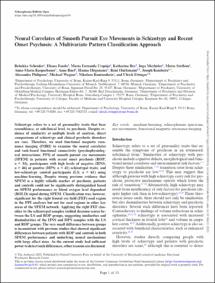Schröder, Rebekka; Faiola, Eliana; Urquijo, Maria Fernanda; Bey, Katharina; Meyhöfer, Inga; Steffens, Maria; Kasparbauer, Anna-Maria; Ruef, Anne; Högenauer, Hanna; Hurlemann, René; Kambeitz, Joseph; Philipsen, Alexandra; Wagner, Michael; Koutsouleris, Nikolaos; Ettinger, Ulrich: Neural Correlates of Smooth Pursuit Eye Movements in Schizotypy and Recent Onset Psychosis : A Multivariate Pattern Classification Approach. In: Schizophrenia Bulletin Open. 2022, vol. 3, iss. 1, 1-13.
Online-Ausgabe in bonndoc: https://hdl.handle.net/20.500.11811/10807
Online-Ausgabe in bonndoc: https://hdl.handle.net/20.500.11811/10807
@article{handle:20.500.11811/10807,
author = {{Rebekka Schröder} and {Eliana Faiola} and {Maria Fernanda Urquijo} and {Katharina Bey} and {Inga Meyhöfer} and {Maria Steffens} and {Anna-Maria Kasparbauer} and {Anne Ruef} and {Hanna Högenauer} and {René Hurlemann} and {Joseph Kambeitz} and {Alexandra Philipsen} and {Michael Wagner} and {Nikolaos Koutsouleris} and {Ulrich Ettinger}},
title = {Neural Correlates of Smooth Pursuit Eye Movements in Schizotypy and Recent Onset Psychosis : A Multivariate Pattern Classification Approach},
publisher = {Oxford University Press},
year = 2022,
month = jun,
journal = {Schizophrenia Bulletin Open},
volume = 2022, vol. 3,
number = iss. 1,
pages = 1--13,
note = {Schizotypy refers to a set of personality traits that bear resemblance, at subclinical level, to psychosis. Despite evidence of similarity at multiple levels of analysis, direct comparisons of schizotypy and clinical psychotic disorders are rare. Therefore, we used functional magnetic resonance imaging (fMRI) to examine the neural correlates and task-based functional connectivity (psychophysiological interactions; PPI) of smooth pursuit eye movements (SPEM) in patients with recent onset psychosis (ROP; n = 34), participants with high levels of negative (HNS; n = 46) or positive (HPS; n = 41) schizotypal traits, and low-schizotypy control participants (LS; n = 61) using machine-learning. Despite strong previous evidence that SPEM is a highly reliable marker of psychosis, patients and controls could not be significantly distinguished based on SPEM performance or blood oxygen level dependent (BOLD) signal during SPEM. Classification was, however, significant for the right frontal eye field (FEF) seed region in the PPI analyses but not for seed regions in other key areas of the SPEM network. Applying the right FEF classifier to the schizotypal samples yielded decision scores between the LS and ROP groups, suggesting similarities and dissimilarities of the HNS and HPS samples with the LS and ROP groups. The very small difference between groups is inconsistent with previous studies that showed significant differences between patients with ROP and controls in both SPEM performance and underlying neural mechanisms with large effect sizes. As the current study had sufficient power to detect such differences, other reasons are discussed.},
url = {https://hdl.handle.net/20.500.11811/10807}
}
author = {{Rebekka Schröder} and {Eliana Faiola} and {Maria Fernanda Urquijo} and {Katharina Bey} and {Inga Meyhöfer} and {Maria Steffens} and {Anna-Maria Kasparbauer} and {Anne Ruef} and {Hanna Högenauer} and {René Hurlemann} and {Joseph Kambeitz} and {Alexandra Philipsen} and {Michael Wagner} and {Nikolaos Koutsouleris} and {Ulrich Ettinger}},
title = {Neural Correlates of Smooth Pursuit Eye Movements in Schizotypy and Recent Onset Psychosis : A Multivariate Pattern Classification Approach},
publisher = {Oxford University Press},
year = 2022,
month = jun,
journal = {Schizophrenia Bulletin Open},
volume = 2022, vol. 3,
number = iss. 1,
pages = 1--13,
note = {Schizotypy refers to a set of personality traits that bear resemblance, at subclinical level, to psychosis. Despite evidence of similarity at multiple levels of analysis, direct comparisons of schizotypy and clinical psychotic disorders are rare. Therefore, we used functional magnetic resonance imaging (fMRI) to examine the neural correlates and task-based functional connectivity (psychophysiological interactions; PPI) of smooth pursuit eye movements (SPEM) in patients with recent onset psychosis (ROP; n = 34), participants with high levels of negative (HNS; n = 46) or positive (HPS; n = 41) schizotypal traits, and low-schizotypy control participants (LS; n = 61) using machine-learning. Despite strong previous evidence that SPEM is a highly reliable marker of psychosis, patients and controls could not be significantly distinguished based on SPEM performance or blood oxygen level dependent (BOLD) signal during SPEM. Classification was, however, significant for the right frontal eye field (FEF) seed region in the PPI analyses but not for seed regions in other key areas of the SPEM network. Applying the right FEF classifier to the schizotypal samples yielded decision scores between the LS and ROP groups, suggesting similarities and dissimilarities of the HNS and HPS samples with the LS and ROP groups. The very small difference between groups is inconsistent with previous studies that showed significant differences between patients with ROP and controls in both SPEM performance and underlying neural mechanisms with large effect sizes. As the current study had sufficient power to detect such differences, other reasons are discussed.},
url = {https://hdl.handle.net/20.500.11811/10807}
}






